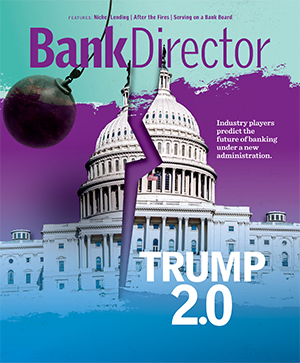
The Potential Impacts of the GENIUS Act on Banking Regulations
While the legislation has not yet made its way to the Senate floor, if passed, it would define the regulatory requirements for stablecoin.
Brought to you by Dinsmore & Shohl LLP

On March 13, the U.S. Senate Committee on Banking, Housing, and Urban Affairs voted to advance the Guiding and Establishing National Innovation for U.S. Stablecoins (GENIUS) Act through committee. According to Chairman Tim Scott’s remarks addressing its legislative markup, the GENIUS Act is intended to provide clarity to both financial institutions and consumers on digital assets, and “is a bipartisan step forward in ensuring stablecoins are safe and reliable tools in the financial system.” By moving the GENIUS Act out of committee, Congress is signaling bipartisan support for establishing a place for stablecoins in the financial sector.
While the GENIUS Act has not yet made its way to the Senate floor, if passed in its current iteration, it would define a stablecoin as a digital asset used for payment or settlement at a fixed monetary value. Further, stablecoins would have to be fully backed, on a one-to-one basis, by the U.S. dollar, Treasury bills or similar assets — this is what provides their stability.
The GENIUS Act limits applications to become stablecoin issuers to select groups:
1. Subsidiaries of insured depository institutions that have been approved by the depository institution’s primary federal regulator.
2. Non-Federal Deposit Insurance Corp. insured institutions regulated by the Office of the Comptroller of the Currency (OCC).
3. State-chartered entities regulated by state regulatory entities.
For issuers of more than $10 billion in stablecoins, the Federal Reserve’s regulatory framework would apply to depository institutions, and the OCC’s regulatory framework would apply to nonbank issuers. States would be permitted to regulate issuers under $10 billion in market capitalization. In committee, the GENIUS Act was amended to establish a prohibition on interest, clarifying that stablecoin would not be eligible for deposit insurance and would require compliance with anti-money laundering rules.
Although the GENIUS Act has only just passed committee, the bipartisan support in committee seems to signal that action could be on the horizon. Banks can consider the following items in preparation:
1. The operative provisions of the GENIUS Act establish a regulatory regime in which banks currently operate, positioning banks at the forefront of stablecoin issuers. Banks already comply with much of the regulatory oversight required by the GENIUS Act, and the changes in committee to impose additional anti-money laundering and other requirements further push the regulation of stablecoin into regimes in which banks operate.
2. To the extent banks would eventually like to capitalize on stablecoin opportunities, they should consider starting the process to establish subsidiaries early. The process to establish a subsidiary can involve a regulatory application, as well as a waiting period for a response. While the GENIUS Act is not yet law, banks that may be interested in issuing stablecoin should spend some time looking at the requirements for establishing a subsidiary. The requirements vary depending on the regulators involved, but banks can anticipate a month or longer lead time in establishing a subsidiary once they are ready to.
3. Banks should consider the technological infrastructure needed to issue stablecoin. Even outside of the regulatory application process to become an issuer, creating and establishing a digital asset takes both technological and physical resources. In addition to establishing a reserve for the stablecoin product, issuers would have to choose a blockchain platform for the stablecoin and make sure there is adequate cybersecurity in place to support the digital asset. Given the regulatory focus the past few years on cyber risk, banks interested in issuing stablecoin should be sure their cybersecurity program is robust.
4. Banks that do not want to issue stablecoin should consider partnerships. If a bank isn’t sure they would like to be a stablecoin issuer, one alternative to pursue may be establishing a partnership with a stablecoin issuer. By making themselves aware of their options early on, even those banks that don’t want to issue stablecoin will be able to position themselves with partnerships to participate in the digital asset community, should they desire.




